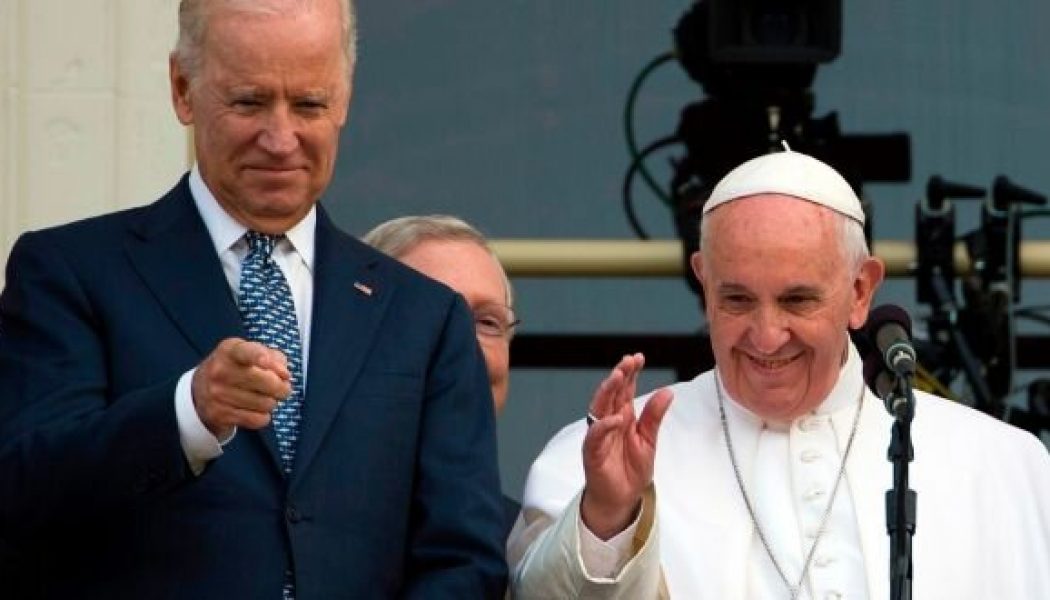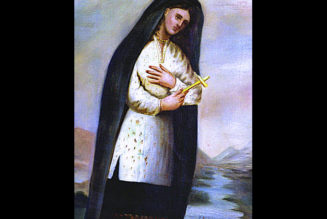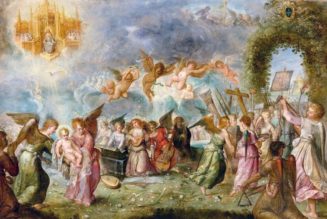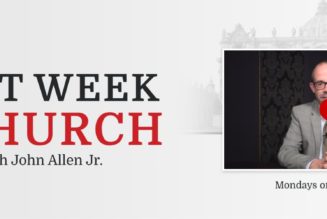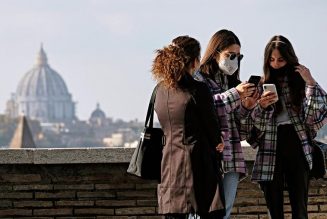
I am not a very good prognosticator. Yet this is the time of year that forces many journalists to do just that.
What will 2021 bring? That’s the big question following a 2020 that will forever remain a year where the world was held hostage by a pandemic. It was also a year where we had a combative presidential election and a reawakened social justice movement that brought our divided politics out into our streets. Could any of us have accurately predicted what 2020 would have been like? I don’t think so.
That hasn’t stopped many from trying to predict what next year will be like. The vaccine could bring with it prosperity and freedom again, but a new strain of the virus has forced much of Europe into lockdown once again. A lot of what 2021 will look like — in terms of religion and faith — will depend on the virus and how politicians choose to handle it.
It’s true that the pandemic exposed all kinds of issues in our society. The journalism that is tasked with objectively reporting these issues so that citizens can make informed decisions failed us miserably, a trend that was years in the making, but peaked in 2020 with the presidential election. My post from this past June highlighted this extremely difficult realization for me after more than 20 years in the business. Here’s the main thrust of that post:
News coverage — be it about politics, culture or religion — is largely made up of crimes (in the legal sense) or lapses in judgement (in a moral one). But the news media has changed in the Internet age, primarily because of social media. Facebook, Twitter and TikTok, to name just three, allows users — everyday people — to pump out content. That content can take many forms — from benign observations to what’s called hot takes — for all to read and see.
Truth, fact checking and context are not important. What matters are likes and followers. What we have now is something some have called “The Great Awokening” and it appears to have forever transformed our political discourse and the journalism that tries to report on it.
Mainstream news organizations, in their quest for clicks amid hope of figuring out a new business model, now mirror the content we all see on social media platforms. Newsrooms loaded with a younger generation who grew up in this environment have imposed their own woke politics as their morality thermometer.
The news media both underplayed COVID-19 and then hyped it, only to pause their concern in the wake of the George Floyd protests. For a list of 2020 media misses, check out this roundup.
That’s in the past now, but we will indeed be talking about 2020 for years and decades to come. Instead of trying to predict the future, the aim of this post is to advise mainstream journalists on what the major Catholic news storylines will be over the next 12 months — in the United States and the world. Yes, the virus will be here for at least a little longer and that will influence the incoming Biden administration and how the U.S. Supreme Court will deal with religious liberty conflicts. (Yes, and watch those two U.S. Senate seats in Georgia.)
Globally, what Pope Francis says and does will have reverberations across the Catholic world and in the United States. Catholic media on the doctrinal left and right will continue to spar and frame stories to their niche audiences. That will likely be the only accurate prediction anyone can make going into a new year.
Here’s a look at five storylines to keep an eye on in 2021:
Pope Francis visits the Middle East — A trip that was postponed in 2020 because of the virus, Pope Francis now plans to visit Iraq this year. This is not only an important trip in terms of geopolitics, but carries with it lots of religious meaning for the Christian minority who live in the majority Muslim nation. Even before the pope steps foot on Iraqi soil, the parliament made Christmas a national holiday.
A news story from Catholic News Agency can serve as a guide for secular press coverage. Here’s how that piece opened:
Iraqi Archbishop Bashar Warda has said that Pope Francis’ upcoming visit to the country could be a turning point for the country’s diminished Christian population, who face ongoing challenges amid Iraq’s unfolding economic crisis.
In an interview with CNA, the Chaldean Catholic Archbishop of Erbil said that Pope Francis’ March 5-8 apostolic trip would be “historic.” It will be the first papal trip to Iraq, a country where Christianity dates back to the first century.
“It has the potential to change the trajectory of the Christian presence in Iraq from one of a disappearing people to one of a surviving and thriving people,” Warda said.
Since the Islamic State occupied parts of northern Iraq in 2014, the number of Christians living in the formerly occupied areas has declined from 102,000 to 36,000.
Some displaced Christians have returned to the Nineveh Plains, in northern Iraq, as their homes were rebuilt, but more Christian families left the region than returned to their hometowns last year, according to a report by Aid to the Church in Need.
Economic instability and continued security challenges have been the forces driving this continued emigration.
Indeed, Iraq is a place Americans know well since we have had a presence there since for the past two decades. Nonetheless, a papal trip has a way of changing hearts and minds. John Paul II’s travels during his pontificate are proof of that. This pope will look to try and do the same. Some in the press already treat the pontiff as a global rock star. it will be interesting to see how this trip is covered.
Ongoing clergy sex abuse payouts — In a year dominated by bad economic news stemming from the pandemic, the lawsuits the church has had to pay out as a result of the clergy sex abuse didn’t get the coverage it deserved.
While the mainstream press focused on how much PPP aid churches received, it remained a bad year in terms of finances for various dioceses. The virus wasn’t the only strain. The payouts from decades-old accusations of sex abuse by priests also cost them money – and will continue to do so in 2021.
The latest example was the Diocese of Pittsburgh, forced to pay $19 million to victims. Local news coverage has led in this effort, outlining how these lawsuits have impacted their local church. Here’s an example from the Observer-Reporter near Pittsburgh:
The Catholic Diocese of Pittsburgh announced Thursday it has paid more than $19 million to victims of childhood sexual abuse by clergy from a compensation fund, and that all claims have been processed.
The diocese said $19.2 million had been paid to 224 claimants. A total of 369 claims were submitted since the Independent Reconciliation and Compensation Program (IRCP) was announced by Bishop David Zubik in December 2018.
The program was established four months after a grand jury report released by the office of Pennsylvania Attorney General Josh Shapiro revealed widespread sexual abuse of children by priests had taken place in parishes across the commonwealth over several decades. The report also found, in some cases, reports of the abuse were ignored or covered up.
Of the 369 claims that were submitted, 70 were deemed ineligible and two were withdrawn. Twenty-one of the claimants did not respond to their offers, and 52 rejected them.
The diocese raised the $19 million it is paying out through insurance, the closure of the pastoral center in downtown Pittsburgh, and the sale of historical assets within the diocese, such as the property where the St. Joseph Protectory for Homeless Boys, which closed in the 1950s, once stood. The diocese has emphasized that no money earmarked for parishes or schools has been used to pay sexual abuse victims.
That AG report will continue to haunt the church, specifically in Pennsylvania. For journalists, the best way to keep up with all that’s going on in various parishes and dioceses is to set up a Google alert system. That’s the best way to follow trends, especially if working for a national outlet. In addition, the closures of Catholic schools and centers could have reverberations for the poor and a variety of communities across that state and the country as the church’s finances continue to be strained by past coverups.
Supreme Court rulings on religious liberty — As many journalists continue to function as woke stewards of the zeitgeist, coverage of religious liberty will continue to be covered by legacy mainstream news outlets as reverse discrimination. While religious freedom involves many faith traditions, the Catholic church has been at the center of many past and present battles.
The addition of Justice Amy Coney Barrett to the bench in 2020 will make a difference, in the eyes of some conservatives, but there is no accurate way to predict the future when it comes to future cases. It’s true conservatives hold a 6-3 majority, but Chief Justice John Roberts hasn’t been shy during the Trump years of joining the liberal justices. Also, did anyone see the independence shown by Justice Neil Gorsuch?
In terms of religious liberty, a piece in The Atlantic tried to put into context what we could expect in 2021 from a perspective many in the secular news media currently share. Note that the term religious liberty in the subhead is in quotes. Here’s the main point from this analysis:
But this legal offensive to elevate “religious liberty” over other civic goals is coming even as the share of Americans who ascribe to no religious faith is steadily rising, and as white Christians have fallen to a minority share of the population.
That contrast increases the likelihood of a GOP-appointed Court majority sympathetic to the most conservative religious denominations colliding with the priorities of a society growing both more secular and more religiously diverse, especially among younger generations.
While most conservative analysts have cheered the Court’s moves in this area, centrist and liberal critics see the ingredients for a political explosion as the Court backs religious-liberty exemptions to laws on employee rights, health care, education, and equal treatment for the LGBTQ community.
Notice that “centrist and liberal critics” are opposing what used to be bipartisan First Amendment liberalism, as recently as the Bill Clinton era.
The First Amendment gives Americans the right to a free speech and press. It also gives Americans the freedom to practice their religious beliefs. The defenders of free speech aren’t always so quick to defend religion. Look for this battle to continue and the Catholic church to lead it.
At the same time, there is a growing cultural and religious divide between evangelicals and traditional Catholics and the rest of the secular nation. With Trump no longer in the White House, these issues would seem to disappear. Alas, they won’t given President-elect Joe Biden’s proclivities to use religious language, despite his own issues with Catholicism.
<div class="sqs-block embed-block sqs-block-embed" data-block-json="{"cache_age":"3153600000","authorUrl":"https://twitter.com/FRCdc","width":550,"height":null,"hSize":null,"resolveObject":"Tweet","html":"
Recent #SCOTUS decisions to protect the #1A rights of churches and religious groups is a welcome sign that the court is recognizing, \"that the Constitution does not take a sabbatical, and that the religious freedom of all Americans must be safeguarded.\" https://t.co/KslwtoDtCj
\u2014 Family Research Council (@FRCdc) December 16, 2020
\n","url":"https://twitter.com/FRCdc/status/1339357836816605184","resolvedBy":"twitter","floatDir":null,"authorName":"Family Research Council","version":"1.0","resolved":true,"type":"rich","providerName":"Twitter","providerUrl":"https://twitter.com"}” data-block-type=”22″ id=”block-yui_3_17_2_1_1608651860917_23127″>
Recent #SCOTUS decisions to protect the #1A rights of churches and religious groups is a welcome sign that the court is recognizing, “that the Constitution does not take a sabbatical, and that the religious freedom of all Americans must be safeguarded.” https://t.co/KslwtoDtCj
— Family Research Council (@FRCdc) December 16, 2020
How churches handle the ongoing pandemic — This next issue dovetails with the aforementioned religious liberty issue. The ongoing pandemic and the ensuing church closings have only doused gasoline on this ongoing fight.
One of major storylines early on in the pandemic was the creativity churches employed — with help from technology — to livestream Masses. Here’s how Crux looked back on the growing trend:
As the coronavirus pandemic upended normal activities and routines across the United States, Catholic parishes, schools and organizations had to quickly, and continuously, find ways to adapt.
For starters, this primarily involved technology: livestreaming Masses and teaching and meeting on Zoom platforms, but it also prompted outdoor worship, drive-thru confessions and, as the year went on: A return to socially distanced in-person Masses and classes at Catholic schools and colleges, with reduced crowd sizes.
When the pandemic first hit and dioceses around the country closed churches and bishops issued dispensations for the Sunday Mass obligation, parishes — with varying degrees of technical know-how — set up parish YouTube channels for the first time or dusted off their Facebook pages for online streaming.
We will all remember how many states rushed to make liquor stores essential businesses, but houses of worship were shuttered during Lent and on Easter. Those issues won’t go away in 2021, although the appetite by the secular press to cover such issues fairly doesn’t seem to be there in our polarized news-media climate.
As for the events of the past year, how will this trend affect religion, and specifically Catholicism, in America is something to keep tabs on. Will all these remote church folks transfer over to in-person attendance once the pandemic subsides? That remains to be seen.
Biden’s politics versus his faith — Biden’s defeat of President Trump will change where this country is going over the next four years. The discussion over Biden’s faith and the intra-Catholic battle it has unleashed among Americans across the doctrinal spectrum will play out for the next few years in both the secular and religious press.
How Catholic issues will shape the news cycle is something I’ve written about already in recent weeks. One of the first issues will be which local parish Biden will choose to attend. Here’s how the National Catholic Reporter speculated on where Biden will go each Sunday after being inaugurated.
In recent decades, church attendance has been a closely watched and delicate matter for the commander in chief. Despite a base of evangelical voters, President Donald Trump spent most Sundays on the golf course. President Barack Obama never had a home church while living in Washington, D.C., and President George W. Bush’s church preference was at Camp David’s chapel with military service members. President Bill Clinton, however, was a regular at Foundry Methodist Church and President Jimmy Carter attended and even taught Sunday school at First Baptist Church of D.C.
Yet as the nation’s second Catholic president, as part of a faith that teaches there is a Sunday obligation to attend Mass, and as a candidate and now president-elect that has shown he’s taken it seriously, Biden will have a range of options.
In the immediate vicinity of the White House are St. Patrick Catholic Church (0.7 miles away), the Cathedral of St. Matthew the Apostle (1 mile), St. Mary Mother of God Catholic Church (1 mile), and St. Stephen Martyr Catholic Church (1.3 miles), to name just a few of his options for Sunday Mass.
No story about Biden’s faith would be complete without mentions of John F. Kennedy, the nation’s first Catholic president. Here’s more from the NCR story:
Christina Cox, author of the book Catholics in Washington, D.C., said that when John F. Kennedy was elected the first Catholic president in 1960, he made his decision with one major consideration in mind: location.
“He didn’t want to go too far from the White House,” Cox told NCR, noting that Kennedy didn’t just attend Mass on Sunday but would periodically attend during the week.
“Kennedy’s mother always reminded him, ‘Jack, don’t forget to go to Mass,’ ” said Cox.
While Kennedy did attend Mass at St. Matthew’s Cathedral, Cox said that he was more at home at St. Stephen Martyr in Foggy Bottom, where he received less attention than he did at the downtown cathedral, and for that reason, the Secret Service also preferred St. Stephen’s.
Today, a plaque commemorates the seventh pew from the back, on the right, in which the Kennedy family would sit. “He didn’t sit too close to the front in case he needed to make a beeline out,” said Cox.
Yes, Biden will attend Mass each Sunday and reporters will be there — either inside or outside — with recaps of what happened dominating the typically slow Sunday news cycle.
It would help if reporters bought a few Bibles and also found copies of the Catechism of the Catholic Church to consult and bookmark. Also, find experts — left and right — on Catholic Canon law.
Why? Biden isn’t afraid to quote scripture in his speeches and Sunday homilies may end up influencing policy and political discourse in his administration. Also, reporters can expect to see conservative Catholics protesting Biden’s actions, from time to time.
Journalists will need these logical resources during Biden’s presidency as we head into 2021.
Join Our Telegram Group : Salvation & Prosperity
